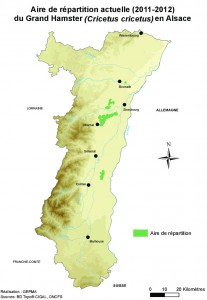In France, the European Hamster only lives in Alsace. It has been living there as a wild animal for 12,000 years. It dug its burrows, just a century ago, almost everywhere in the Alsatian plains, preferring dry and rich earth whenever possible. Its preferred fields are winter grains such as wheat and barley as well as alfalfa, and when that is not possible, beet or cabbage fields.

The rarefaction of the European Hamster in Alsace
At the end of the 1970s, this species declined sharply. This stems from several factors:
-
Cereal harvest dates were moved up, spring crops such as maize, beets and potatoes took their place, and this reduced the time of a protective vegetative cover,
- Simplification of the agricultural landscape and the size of fields;
-
Use of chemical products on crops,
-
Reducing the size of fields by construction of roads and towns.
All of these changes have impacted its habitat and life style, which has endangered its reproduction and chance to escape predators: the Red Fox, mustelids, (Beech Marten, Skunk, Hermine), as well as prey birds such as Buzzards, Long Eared Owls, and Eurasian Tawny Owls.
This mammal is one of the most endangered species in Europe.
Today, the European Hamster is in danger of extinction. Though at the end of the 19th century, there were still thousands of hamsters in Alsace, today their population has dwindled to only 500 to 1,000 individuals, present in about twenty different municipalities. The three main populations are located in Obernai, Geispolsheim and Elsenheim in the French Bas-Rhin department. Though their population has stabilised, it is still well below the critical threshold to survive.
Glossary
Alfalfa: Plant cultivated to feed cattle, which looks like trefoil.

